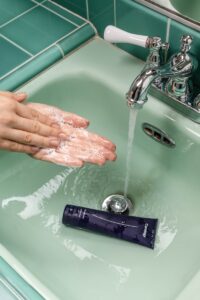In the realm of skincare, hydration and moisturization are often confused as the same thing. However, these two concepts play different yet significant roles in maintaining healthy skin. This comprehensive guide will delve into the science of hydration and moisturization, their differences, and their respective importance to various skin types.
Chapter 1: Understanding the Distinction
Hydrators Versus Moisturizers: The Basic Difference
When it comes to skincare nomenclature, the terms ‘hydration’ and ‘moisturization’ are often used interchangeably. However, they serve unique functions when it comes to maintaining the health of your skin.
To put it simply, hydrators such as humectants draw water from the atmosphere or your skin to keep it moisturized, whereas moisturizers like emollients, oils, and squalene form a seal on the skin’s surface, locking in moisture to keep it soft and supple.
A Common Query: Can Water Alone Moisturize the Skin?
The answer is no. In its pure form, water isn’t potent enough to keep your skin moisturized. It evaporates quickly, sometimes even stripping away your skin’s natural oils. The more frequently you wash your skin without applying a moisturizer or hydrator, the higher the chances of your skin drying out.
Scientific Explanation: The Role of Occlusives and Humectants
In the skincare industry, the terminology has evolved, making it essential to understand the difference between occlusives (moisturizers) and humectants (hydrators).
Moisturizers, or occlusives, are oil-based ingredients that form a seal on the skin’s surface, preventing water from escaping, and thereby making the skin feel smoother and less dry. On the other hand, hydrators are humectants like glycerin or hyaluronic acid that absorb water and hold it in place on your skin.
The way these two components work is vastly different, making it crucial for you to choose the right product based on your skin type.
Chapter 2: Choosing the Right Product for Your Skin Type
Catering to Dry Skin: The Role of Thicker Moisturizers
If your skin tends to be dry throughout the year and is prone to flaking or peeling, it implies that your skin struggles to retain moisture. In such cases, a thick, emollient moisturizer can create a protective seal on the skin’s surface, locking in moisture, and providing the much-needed nourishment.
Ingredients to Look Out For: Petrolatum, plant oils like jojoba oil, and nut oils like coconut oil.
Addressing Dehydrated Skin: The Power of Hydrating Serums
Dehydrated skin needs to actively replenish its water content. A hydrating serum with hyaluronic acid, which retains an impressive 1,000 times its weight in water, can provide a healthy dose of hydration back into the skin.
Ingredients to Look Out For: Hyaluronic acid, aloe vera, and honey.
Hydrate from Within
- Aim to [consume an adequate amount of water](https://www.healthline.com/nutrition/how-\n> much-water-should-you-drink-per-day) daily. A good target is at least half of your body weight in ounces of water each day. If you weigh 150 pounds, aim for 75 ounces of water per day.
- Incorporate foods with high water content such as watermelon, strawberries, and cucumber into your diet. These can help hydrate your skin and body.
Tackling Oily Skin: The Benefits of Water-Based Hydrators and Moisturizers
Even if you have oily skin, it doesn’t necessarily mean that your skin is well-hydrated. Dehydrated skin can exacerbate oil production. Individuals with oily skin often have compromised skin barriers, making it difficult for their skin to retain moisture. The lack of moisture can lead to more oil production, creating a vicious cycle. To break this cycle, your skin needs appropriate hydration and moisture.
Opt for water-based, non-comedogenic hydrators and moisturizers. These products feel lighter on the skin and won’t clog your pores.
Chapter 3: Decoding Product Labels
When it comes to ensuring your skin is adequately hydrated, the question often arises: should you use a hydrator or a moisturizer? The answer, in fact, is probably both. However, it’s important to understand what the ingredients in your skincare products do.
Here’s a handy table to help you identify whether a product will moisturize or hydrate your skin:
| Ingredient | Moisturizer (Occlusive) or Hydrator (Humectant) |
|---|---|
| Hyaluronic Acid | Humectant |
| Glycerin | Humectant |
| Aloe | Humectant |
| Honey | Humectant |
| Nut or Seed Oil (Coconut, Almond, Hemp) | Occlusive |
| Shea Butter | Occlusive |
| Plant Oils (Squalene, Jojoba, Rosehip, Tea Tree) | Occlusive |
| Snail Mucin | Humectant |
| Mineral Oil | Occlusive |
| Lanolin | Occlusive |
| Lactic Acid | Humectant |
| Citric Acid | Humectant |
| Ceramide | Neither (Ceramides strengthen the skin’s barrier to help prevent moisture loss) |
Remember, you can use both a moisturizer and a hydrator. First, apply hydrating ingredients like hyaluronic acid and then follow up with an occlusive like plant oils to lock in the moisture. If you want to keep it simple, look for a product that does both. Face masks are a great option to hydrate and moisturize your skin with a single product.
Maintaining a plump, hydrated complexion year-round isn’t about choosing one over the other. The key is understanding when and how to use both hydration and moisturization based on your skin’s needs.
















+ There are no comments
Add yours